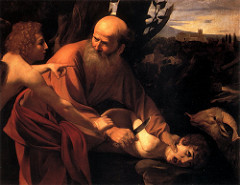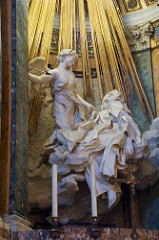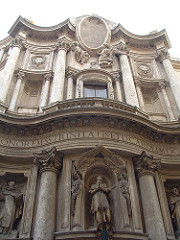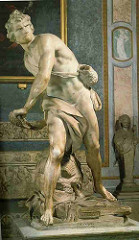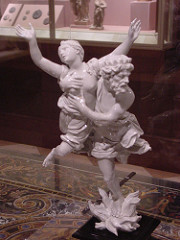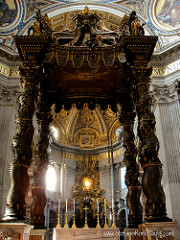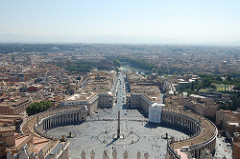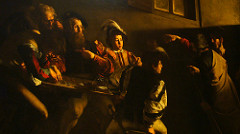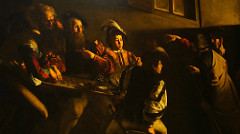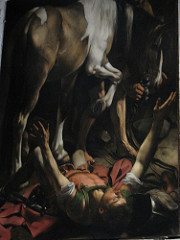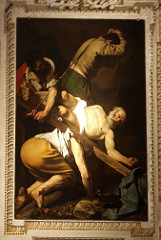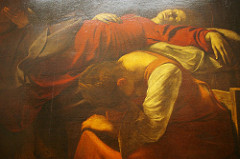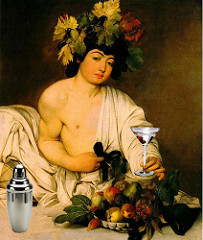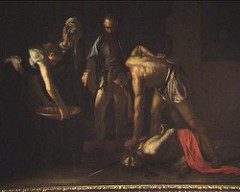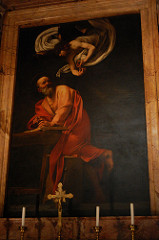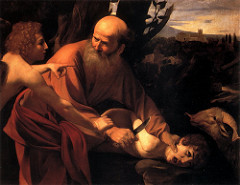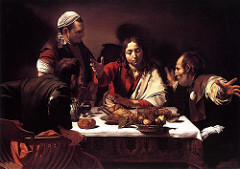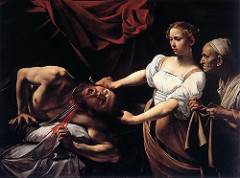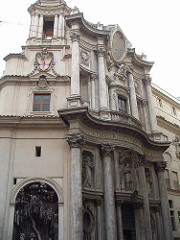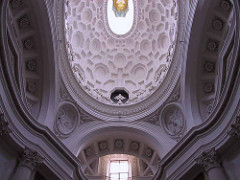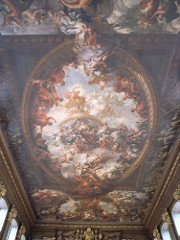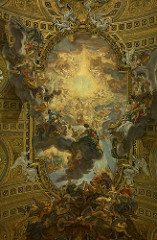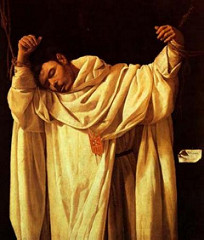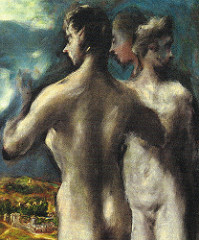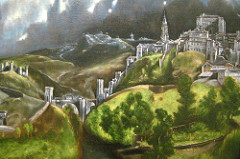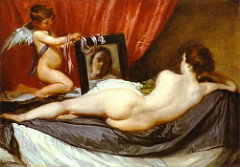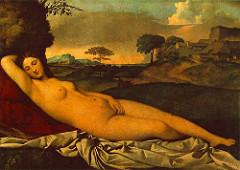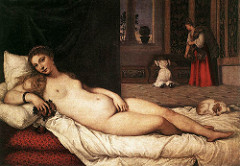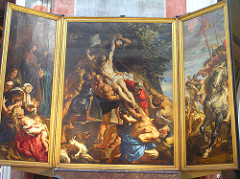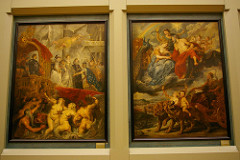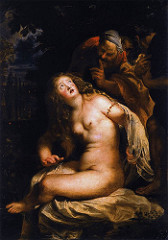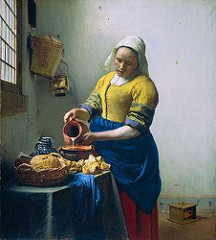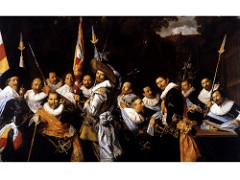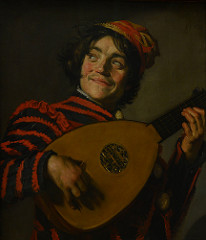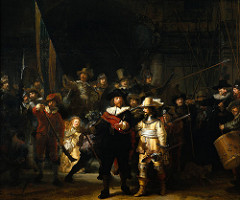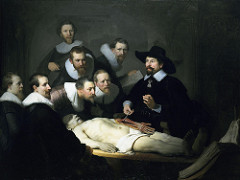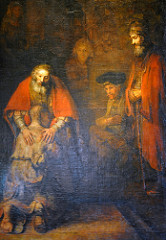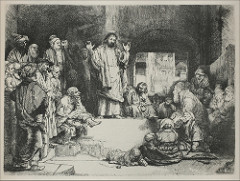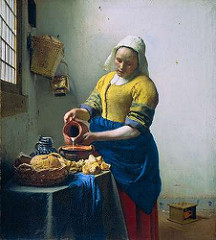Date for Baroque Era
1600-1750
1600- a year of the first opera production
Main Question 1- Who was the main patron for Italian Baroque art?
The Churches
Main Question 2- What was the function of most Italian Baroque art?
To encourage the faithful to return to the Catholic Church (mostly as response to Counter-Reformation)
Main Question 3- 3 characteristics of Caravaggio's art
His pictures tended to be large, brightly lit (usually used tenebrism), and set close to the picture lane/ foreground
Main Question 4- Why Bernini's David is considered the first Baroque sculpture
Was a new type of 3-dimensional composition that intrudes forcefully on the viewers' space. It bends at waist and twists far to one side, ready to launch the lethal rock. Unlike Michelangelo's cool and self-confident lean, sinewy body, this more mature David is all tension and determination, a tightly clenched mouth, and straining muscles. Forces Viewers to take action in the scene. (Also, emotion and clothing)
Main Question 5- How Borromini's Baroque buildings differed from Alberti's Renaissance buildings
His buildings had more movement, such as the San Carlo alle Quattro Fontane with an undulating front, deep niches that create dramatic effect of light and shadow, also gives it a windowed niche covered with a pointed canopy.
Main Question 6- The reason Gentileschi is considered a Caravaggista
Her use of contrasting light, and naturalistic yet dramatic figures.
Vocab-
1. Counter-Reformation
2. Baldachino
3. Tenebrism
4. Caravaggista
1. Program of renewal by Catholic Church intened to bring believers back to church
2. Canopy, for the high altar of Saint Peter's
3. The strong use of chiaroscuro and artificially illuminated areas to create a dramatic contrast of light and dark in a painting
4. Influenced by Caravaggio's techniques
Definiton of Baroque?
The term baroque was not a complement - it originally meant overdone
It has come to include the following definitions:
-Marked by elaborate ornamentation
-Aims to create a dramatic effect
-Appealing to the spirit through the senses
-Enlarged space
-Heightened sensuality combined with spirituality
-Naturalistic rather than ideal, emotional rather than rational
-Conflict, paradox and contrast, heightened spirituality, lively sensuality
-Ornate
Baroque Painting Characteristics
1. Asymmetrical compositions
2. Powerful effects of movement
3. Strong lighting
4. Dramatic interpretations of subject matter
Baroque Sculpture Characteristics
1. Same as painting
2. rich materials
3. surprising light sources
Baroque Architecture Characteristics
Classical orders continued to be used, but are arranged in energetic and dynamic ways.
Baroque Patrons
In Catholic countries the church financed most art, in Protestant countries it was wealthy businessmen who financed art.
Bernini: David
Date: 1600
Artist: Bernini
Medium: Marble
Patron: Cardinal Borghese
Influence: Hellenistic sclupture
Note: Considered first Baroque sculpture
Question: What is Baroque about this sculptue?
(in moment of dramatic action, twisting, diagonal lines, emotion)
Compare the Davids from different time periods
Donatello David
Classical David
Bernini David
Bernini: The Ecstasy of St. Theresa
Date: 1645-52
Patron: Cardinal Cornaro
Location: The Cornaro family chapel, Rome
Subject: A vision experienced by St. Theresa, wherein a angel plunged into her breast a spear symbolizing Divine Love.
Bernini: The Rape of Proserpina
Artist: Gian Lorenzo Bernini
Location: Galleria Borghese
Created: 1621-1622
Media: Marble
Context:
Bernini depicts the peak moment of the story of the Rape of Proserpina, while the characters' are in mid-action. Proserpina is trying desperately to escape Pluto's grasp as he carries her to Hades, which is represented by Cereberus, the three-headed dog. Bernini crafted this piece to be viewed from the front because it is the "explosive energy" of the horrible event taking place and Proserpina's pathetic attempt to defend herself that is at show.
Bernini: Baldachino
Date: 1624-41
Location: Saint Peter's
Material: Bronze (taken from the Pantheon)
Baldachino=Canopy
Commissioned by: Urban VIII
Note: Located directly under Michelangelo's dome and over the tomb of St. Peter.
Symbolism: Bees=Pope's Urban VIII's Barberini family.
*Exemplifies the Baroque artists's desire to combine architecture and sculpture so that works no longer fit into one single category or medium.
*Twisted columns symbolize the union of Old & Testament
*Combines elements of Ionic & Corinthian
Bernini: St. Peter's Basilica
Bernini described the colonnade as a pare of arms spread out to embrace visitors to Saint Peter's Basilica.
Question: How does the addition of the colonnade to St. Peter's reflect the historical time period?
Caravaggio Characteristics
1. Naturalistic Figures lower class—models were often beggars and prostitutes.
2. Dramatic use of Light (Tenebrism—sharp contrast between light and dark) creates drama
3. Dramatic portrayals of decisive moments
4. Unusual Perspective —brings the viewer into the action
Caravaggio: The Incredulity of St. Thomas
Date:1601-02
Medium: Oil on canvas
Location: Rome
*According to St John's Gospel, Thomas missed one of Christ's appearances to the Apostles after His resurrection. He therefore announced that, unless he could thrust his hand into Christ's side, he would not believe what he had been told. A week later Christ appeared, asked Thomas to reach out his hands to touch Him and said, 'Blessed are those who have not seen and yet have believed.'
Caravaggio: The Calling of Saint Matthew
Date: 1599-1600
Medium: Oil on Canvas
Location: Contarelli Chapel, Church of San Luigi dei Francesi
*Subject: The moment Christ walks into a tavern and ask Matthew to be his apostle.
Technique: tenebrism
*For all his naturalism, Caravaggio also used antique and Renaissance sources
Caravaggio: The Conversion of St. Paul
Date: 1600's
Artist: Caravaggio
Caravaggio: The Crucifixion of Saint Peter
Date: 1600's
Artist: Caravaggio
Caravaggio: The Death of the Virgin
Date: 1600's
Artist: Caravaggio
Caravaggio: Bacchus
Artist: Caravaggio
Not afraid to use pagan Greek and Roman figures in art.
Caravaggio: The Decapitation of Saint John the Baptist
Artist:
Caravaggio: The Inspiration of St. Matthew
Caravaggio: The Sacrifice of Issac
Caravaggio: Supper at Emmaus
Caravaggio: Judith Beheading Holofernes
Artemesia Gentileschi: Judith Beheading Holofernes
Date: c. 1598
Artist: Gentileschi
*Caravaggista—followers of Caravaggio's style.
Subject: Judith saved her besieged town from the Assyrian army by seducing its general, Holofernes, getting him drunk, and then cutting off his head with his own sword.
Mary Magdalen
Date: (Italian 1593-1651)
Artist: Gentileschi, Artemisia
Borromini: San Carlo alle Quattro Fontane
Loc: Rome
Date: 1638-41
*Juxtaposes convex and concave surfaces to made the walls seem to ripple.
*Robust pairs of columns support a massive entablature, over which an oval dome seems to foat.
*Coffers (panels in geometric shapes) filling the interior of the dome form an eccentric honeycomb of crosses, elongated hexagons, & octagons
*dome appears to be inflating due to increase in size of coffers as they approach appex.
*To fit the irregular site, he created an elongated central plan interior space with indulating walls, whose powerful, sweeping curves create an unexpected feeling of movement.
Borromini: San Carlo alle Quattro Fontane (Interior)
Baroque Ceiling Paintings
Gaulli: Triumph in the Name of Jesus
Location: Il Gesu, one of the most important churches in Rome.
Subject Matter: The Last Judgement. The elect rise to heaven, while the damned plummet to the ground.
Function: Propaganda for the church during the Counter-Reformation
The Baroque Period in Spain
The Baroque Period in Spain was really the Spanish Renaissance.
Literature was dominated by Cervantes
Art was a tool for the church during the Counter-Reformation
Francisco de Zurbaran: Martyrdom of St. Serapion
Patron: Catholic Church
Subject: Usually martyred saints
Function: Emotionally involve worshippers and encourage greater religious devotion (Counter-Reformation
El Greco: Christ Driving the Traders from the Temple
...
Diego Velazquez: las meninas
Patron: King Philip IV
Subject: Princess Margarita or Velazquez?
Why Important: A self-portrait of the artist at work
Note the types of images:
1. Image on canvas
2. Mirror image
3. Two painted images
Diego: The Water Carrier of Seville
Where do you see the influence of Caravaggio?
Velazquez: Venus at her Mirror
Giorgione: Sleeping Venus
Portraits
Many baroque artists painted portraits for royalty and the wealthy.
Velazquez's Las Meninas is a famous example.
Netherlands/Flanders and the Baroque
By 1609, northern rebels in Flanders won independence from Catholic Church.
The north part of Flanders becomes the Netherlands—Protestant
The south part of Flanders remains under the power of Catholic Church
Ruben's Characteristics
1. Muscular Bodies
2. Bright Colors
3. Movement
4. Dramatic Use of Light
5. Allegory
Peter Paul Rubens: The Raising of the Cross
Location: Antwerp--Southern Netherlands (Flanders)
Function: High Altarpiece triptych
Influence:
1. Michelangelo
2. Caravaggio
3. Titian
Rubens: Arrival of Marie de' Medici at Marseilles
Patron: Marie de' Medici
Function: Series of 21 huge paintings that celebrate the life of Marie de Medici, who was married to Henry IV, the king of France
Technique: Allegory
1. France
2. Fame (with trumpet)
3. Neptune
Rubens: The Consequences of War
Allegory about the outbreak of war.
1. Mars
2. Venus
3. Monsters
4. Women with lute
5. Women with child
6. Architect
7. Book on ground
8. Women in black
Art in the Netherlands
1609—Rebels from the north of Netherlands won independence from Spain.
Country divided in two:
1. Netherlands—North—Protestant
2. Flanders—South--Catholic
Protestant Netherlands: Context
It was a true republic—no traditional hereditary aristocracy.
Netherlands was governed by merchants.
New Patrons=New Art
The religion of the Netherlands was Calvinism ( a sect of Protestantism ) which forbade representations of God or Christ.
No aristocracy meant no mythological paintings.
Middleclass merchants wanted landscapes, portraits, genre paintings for their home
Frans Hals: Archers of St. Hadrian
Patron: Dutch Civic Militia
Challenge: How to create a group portrait, where everyone who paid gets equal representation?
Solution: Create a portrait that shows individuals in the group from different angles, all with unique expressions.
Frans Hals: Ordinary people and their most characteristic expression
Judith Leyster: Self Portrait
Rembrandt - Protestant
...
Rembrandt: Revolutionizes the Group Portrait (The Nightwatch)
Patron: Amsterdam Civic Guard
Subject: An imaginary moment—the civic guard, dressed for war, ready to march.
Note: The dramatic use of light
Why was this painting unusual:
1. Certain patrons were depicted in shadow.
2. Non civic guard members added in for drama.
Rembrandt: The Anatomy Lesson
Patrons: The Surgeons Guild
Why Revolutionary: Rembrandts depicts the guild not posing for a picture, but in action.
Rembrandt: Return of the Prodigal Son
How would you compare this to Italian Baroque religious paintings?
Jan Vermeer - Another master of light!!!
French Baroque (Begins "Neoclassical Era in Art History)
Poussin
French Baroque
French baroque painting included many "natural" landscapes, but the only thing you should care about here is Louis XIV building of Versailles.
